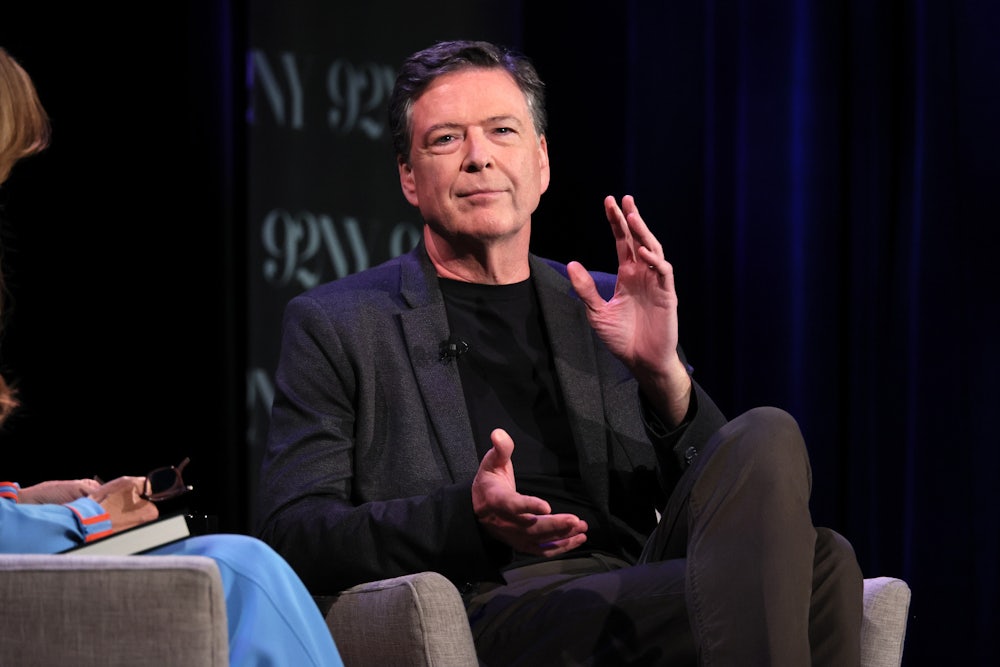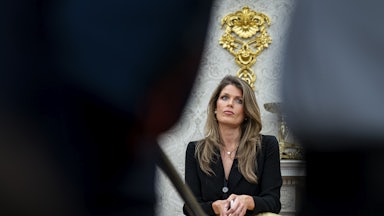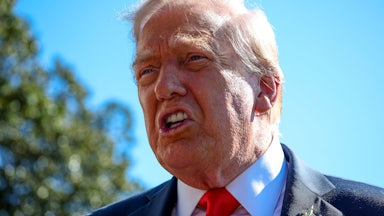The Trump administration’s campaign to prosecute former FBI Director James Comey is going about as badly as it can for the Justice Department. At a hearing on Wednesday, prosecutors admitted that a federal grand jury had never actually voted on the indictment against one of Trump’s top political adversaries before it was filed with the court by federal prosecutors in Virginia in September. The revelation could potentially result in dismissal of all charges against Comey.
Judge Michael Nachmanoff, the presiding trial judge in the case, questioned prosecutors intensely at the hearing about the timeline of events leading up to Comey’s indictment on September 25. According to prosecutors, they had initially presented a three-charge indictment to the grand jury, which declined to approve one of the false-statement charges against Comey.
This was already an unusual move on the grand jury’s part; the cliché is that a decent prosecutor could get one to indict a ham sandwich. (Well, with some notable exceptions.) Prosecutors then revised the indictment to only include the other two charges. Instead of properly submitting that indictment to the grand jury again, they instead submitted the revised version to the court.
Lindsey Halligan, the rookie interim U.S. attorney for eastern Virginia, confirmed that the final indictment was only seen by the grand jury’s foreperson and another member when it was finalized on September 25. Federal prosecutors argued that it wasn’t a new indictment and that the charges were still valid. Comey’s lawyers, as you might imagine, took a much less forgiving view of the matter.
“There is no indictment,” Michael Dreeben, one of Comey’s lawyers, reportedly told Nachmanoff after the Justice Department’s admission. Though it might seem like a technicality, it is a huge one. The Fifth Amendment prohibits felony prosecutions “unless on a presentment or indictment of a grand jury.” As Comey’s legal team explained to the judge, the former FBI director was essentially being prosecuted under a new indictment that no grand jury had approved.
To understand how things got to this point, we must travel back in time to this summer. Trump had repeatedly pressured officials to bring criminal charges against figures like Comey and New York Attorney General Letitia James, the latter of whom was also indicted over dubious allegations of mortgage fraud in recent months. California Senator Adam Schiff and Representative Eric Swalwell, who both played a key role in Trump’s first-term impeachments, are facing similar investigations that have not yet resulted in charges.
The president had already demolished the Justice Department’s post-Watergate tradition of independence, soon after returning to office in January, by appointing his former personal attorneys, including Attorney General Pam Bondi and Deputy Attorney General Todd Blanche, to oversee the department. Those officials have carried out sweeping ideological purges of career department employees for their perceived disloyalty to Trump; hundreds of others have left for work in the private sector amid the tumult.
In Comey’s case, matters came to a head in late September when ABC News reported on September 19 that Eric Siebert, the acting U.S. attorney for the Eastern District of Virginia, was resisting demands to prosecute Comey and James because he thought the cases against them lacked merit. For Trump, who faced two impeachments and four criminal prosecutors over the last decade, the goal is personal revenge.
“We can’t delay any longer, it’s killing our reputation and credibility,” Trump wrote in a post on his personal social media website on September 20. “They impeached me twice, and indicted me (5 times!), OVER NOTHING. JUSTICE MUST BE SERVED, NOW!!!” (It is not clear what he considered to be the fifth indictment.) The post was addressed directly to “Pam,” leading some to initially believe it had been meant as a private message to Bondi.
Siebert resigned on September 20 after Trump publicly demanded his removal. In his place, Trump installed Halligan as the new acting U.S. attorney. The Eastern District of Virginia is among the most important federal-prosecutor offices in the nation in normal times. Since the Pentagon and the CIA’s headquarters are located in its territory, it often oversees complex and sensitive national security cases.
Halligan, for her part, had no prosecutorial experience at all before taking the job two months ago. The 36-year-old attorney is an insurance lawyer by trade and largely worked as one of Trump’s many personal lawyers in recent years. By comparison, Dreeben, who represented Comey at Wednesday’s hearing, argued more than 100 criminal cases before the Supreme Court when he worked in the solicitor general’s office. What Halligan lacked in experience, she made up for with personal loyalty to Trump: The Comey and James prosecutions moved forward despite objections from career prosecutors in the office.
At issue in Comey’s case was a ticking clock: Trump officials wanted to charge him with lying to Congress during a September 30, 2020, hearing on the Russia investigation. Comey told lawmakers that day that he had not authorized anyone at the FBI to leak information to news organizations. At the same time, Trump allies faulted him for leaking information to the press through a non-FBI intermediary after Trump fired him and for allegedly knowing that Andrew McCabe, his former deputy director, had himself authorized leaks to reporters. Comey denied that he had lied to Congress or committed any other wrongdoing.
The two charges—making a false statement to Congress and obstructing a congressional investigation—had a five-year statute of limitations attached to them. As a result, the newly appointed Halligan had only 10 days to bring charges before the opportunity was lost forever. She submitted them to the court on September 25 with only five days to spare.
Comey immediately responded by asking the court to dismiss the charges against him, arguing that he was targeted by a “selective” and “vindictive” prosecution because he had previously criticized Trump. He cited the basic nature of the case—Trump’s public demands, his ouster of hesitant prosecutors, and so on—to support his claim. Comey also alleged that Halligan had been improperly appointed to her post: Federal law imposes unique conditions for interim U.S. attorney appointments, which Comey claimed had been disregarded by Trump and Halligan.
In addition to those claims, Comey also asked a judge to compel the Justice Department to provide him with more documentation about the grand jury proceedings against him. He hinted that an FBI witness may have improperly relied upon information that was protected by attorney-client privilege, as well as other aforementioned grounds. (The non-FBI intermediary, Daniel Richman, is a Columbia University law professor.)
One unspoken but subtextual concern was that federal prosecutors had initially filed two different indictments against Comey on the publicly accessible docket on September 25. One of them contained the two charges against Comey that were running up against the statute of limitations. The other included a third charge. Both had been signed by the grand jury foreperson, at the prompting of a federal magistrate judge during a September 26 hearing.
“So this has never happened before,” Judge Lindseey Vaala told Halligan during the hearing, according to a transcript obtained by CBS News. “I’ve been handed two documents that are in the Mr. Comey case that are inconsistent with one another. There seems to be a discrepancy. They’re both signed by the foreperson.
“The one that says it’s a failure to concur in an indictment, it doesn’t say with respect to one count,” Vaala continued. “It looks like they failed to concur across all three counts, so I’m a little confused as to why I was handed two things with the same case number that are inconsistent.”
Halligan professed ignorance. “So I only reviewed the one with the two counts that our office redrafted when we found out about the two counts that were true billed, and I signed that one,” she claimed. “I did not see the other one. I don’t know where that came from.” Vaala expressed surprise at that claim since Halligan had actually signed both of them.
Comey’s motion and the court’s review culminated in a bombshell November 17 order by Judge William Fitzpatrick, another magistrate judge later assigned to the case, where he granted Comey’s request to review the grand jury materials against him. While this request is “rarely granted,” Fitzpatrick explained, “the record points to a disturbing pattern of profound investigative missteps” that had potentially “undermine[d] the integrity of the grand jury proceeding.”
Fitzpatrick laid out the sequence of events as he understood them. First, prosecutors presented a three-count indictment to the grand jury. The grand jury then rejected one count and found probable cause to support the other two. Prosecutors then prepared a second indictment that omitted the rejected count. Finally, prosecutors submitted both indictments to the court via a magistrate judge, who accepted the revised one after some questioning.
What happened in the time period between when prosecutors prepared the second indictment and when they submitted it to the court? One might assume under normal circumstances that prosecutors simply redid the process. But Fitzpatrick expressed some doubt that this had actually happened, based on the transcript that he had reviewed of the grand jury proceedings. It showed that there was only a seven-minute gap between when prosecutors learned that the first indictment had only been true-billed on two of the three counts and when they submitted a second indictment to the court.
“The short time span between” these two moments, Fitzpatrick noted, “could not have been sufficient to draft the second indictment, sign the second indictment, present it to the grand jury, provide legal instructions to the grand jury, and give them an opportunity to deliberate and render a decision on the new indictment.” He suggested that it was possible that the transcript and audio recordings were “incomplete,” which would raise a host of other concerns.
Alternatively, he noted, “if this procedure did not take place, then the court is in uncharted legal territory in that the indictment returned in open court was not the same charging document presented to and deliberated upon by the grand jury.” This “unusual series of events,” Fitzpatrick concluded, “calls into question the presumption of regularity” that courts normally use for grand jury proceedings and “provides another genuine issue the defense may raise to challenge the manner in which the government obtained the indictment.”
Halligan’s bombshell admissions at Wednesday’s hearing appear to have now solved the mystery: Her office did not actually present the second indictment to the grand jury, and instead obtained the grand jury foreperson’s signature anyway. This gave the second indictment the appearance of approval by the entire grand jury, even though it technically hadn’t approved it, and allowed the case to move forward on schedule.
So what happens now? Comey’s lawyers will undoubtedly call for the case to be dismissed for the glaring procedural error in an upcoming motion. If Nachmanoff grants the dismissal, the question will turn to whether he does so with or without prejudice. While the statute of limitations has technically passed, federal law allows prosecutors to refile charges in dismissed cases for up to six months after the dismissal. Given the Justice Department’s overall conduct in this case (and its alleged misconduct), however, Nachmanoff may instead opt to dismiss the case with prejudice and bring the entire matter to a close.
That would be a fitting end for a case brought by an unqualified and potentially illegal appointee in an apparently vindictive prosecution that had been publicly demanded by the president out of a sense of personal revenge. Trump has long wanted to wield the American criminal justice system as a hammer against his political enemies. In this case, he and his allies can’t stop hitting themselves with it by accident.










